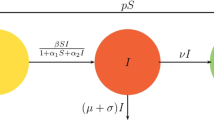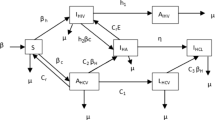Abstract
In this article, we introduce an innovative methodology based on the Fibonacci wavelet and collocation technique for solving the susceptible–infectious–recovered (SIR) model of COVID-19. The SIR model is represented by a system of nonlinear ordinary differential equations. Our approach begins by transforming the given differential equations into an equivalent algebraic form using the basis expansion of Fibonacci wavelets. The collocation technique is then applied, leading to a system of nonlinear equations. To simplify these nonlinear equations, we employ the Newton–Raphson method. Through the utilization of examples under various conditions, we demonstrate the superiority of our method compared to existing approaches. Moreover, we highlight the versatility of our method, showcasing its applicability in solving a range of linear and nonlinear ordinary and partial differential equations across diverse scientific and engineering domains. Figures and Tables are presented to illustrate the accuracy of our solution and the variation in error. Notably, our approach distinguishes itself by requiring less computational effort while delivering enhanced accuracy across a wide spectrum of scenarios. All calculations are performed using MATLAB Software, underscoring the practical implementation of our proposed methodology.







Similar content being viewed by others
Data Availability
Data will be made available on request.
References
Sridhar, V., Ramesh, K., Gnaneswara Reddy, M., Azese, M.N., Abdelsalam, S.I.: On the entropy optimization of hemodynamic peristaltic pumping of a nanofluid with geometry effects. Waves Random Complex Media 1–21 (2022)
Abdelsalam, S.I., Mekheimer, K.S., Zaher, A.Z.: Dynamism of a hybrid Casson nanofluid with laser radiation and chemical reaction through sinusoidal channels. Waves Random Complex Media 1–22 (2022)
Eldesoky, I.M., Abdelsalam, S.I., Abumandour, R.M., Kamel, M.H., Vafai, K.: Interaction between compressibility and particulate suspension on peristaltically driven flow in planar channel. Appl. Math. Mech. 38, 137–54 (2017)
Zhou, F., Yu, T., Du, R., Fan, G., Liu, Y., Liu, Z., Xiang, J., Wang, Y., Song, B., Gu, X., Guan, L.: Clinical course and risk factors for mortality of adult inpatients with COVID-19 in Wuhan, China: a retrospective cohort study. Lancet 395(10229), 1054–62 (2020)
Remuzzi, A., Remuzzi, G.: COVID-19 and Italy: what next? Lancet 395(10231), 1225–8 (2020)
Lin, Q., Zhao, S., Gao, D., Lou, Y., Yang, S., Musa, S.S., Wang, M.H., Cai, Y., Wang, W., Yang, L., He, D.: A conceptual model for the coronavirus disease 2019 (COVID-19) outbreak in Wuhan, China with individual reaction and governmental action. Int. J. Infect. Dis. 93, 211–6 (2020)
Andersen, K.G., Rambaut, A., Lipkin, W.I., Holmes, E.C., Garry, R.F.: The proximal origin of SARS-CoV-2. Nat. Med. 26(4), 450–2 (2020)
Guo, Y.R., Cao, Q.D., Hong, Z.S., Tan, Y.Y., Chen, S.D., Jin, H.J., Tan, K.S., Wang, D.Y., Yan, Y.: The origin, transmission and clinical therapies on coronavirus disease 2019 (COVID-19) outbreak-an update on the status. Mil. Med. Res. 7, 1 (2020)
Kucharski, A.J., Russell, T.W., Diamond, C., Liu, Y., Edmunds, J., Funk, S., Eggo, R.M., Sun, F., Jit, M., Munday, J.D., Davies, N.: Early dynamics of transmission and control of COVID-19: a mathematical modelling study. Lancet. Infect. Dis 20(5), 553–8 (2020)
Hellewell, J., Abbott, S., Gimma, A., Bosse, N.I., Jarvis, C.I., Russell, T.W., Munday, J.D., Kucharski, A.J., Edmunds, W.J., Sun, F., Flasche, S.: Feasibility of controlling COVID-19 outbreaks by isolation of cases and contacts. Lancet Glob. Health 8(4), e488-96 (2020)
Prem, K.: The effect of control strategies to reduce social mixing on outcomes of the COVID-19 epid Wuhan, China: a modelling study. The Lancet Public Health 5(5), 261–270 (2020)
Lepik, Ü.: Application of the Haar wavelet transform to solving integral and differential equations. In: Proceedings of the Estonian Academy of Sciences, Physics, Mathematics, vol. 56, no. 1 (2007)
Srivastava, H.M., Shah, F.A., Nayied, N.A.: Fibonacci wavelet method for the solution of the non-linear Hunter-Saxton equation. Appl. Sci. 12(15), 7738 (2022)
Shah, F.A., Irfan, M., Nisar, K.S., Matoog, R.T., Mahmoud, E.E.: Fibonacci wavelet method for solving time-fractional telegraph equations with Dirichlet boundary conditions. Results Phys. 24, 104123 (2021)
Kumar, S., Kumar, R., Momani, S., Hadid, S.: A study on fractional COVID-19 disease model by using Hermite wavelets. Math. Methods Appl. Sci. 46(7), 7671–87 (2023)
Alzaid, S.S., Kumar, R., Chauhan, R.P., Kumar, S.: Laguerre wavelet method for fractional predator-prey population model. Fractals 30(08), 2240215 (2022)
Venkatesh, S.G., Raja Balachandar, S., Ayyaswamy, S.K., Balasubramanian, K.: A new approach for solving a model for HIV infection of CD4+T-cells arising in mathematical chemistry using wavelets. J. Math. Chem. 54, 1072–82 (2016)
Beler, A., Şimşek, G.Ö., Gümgüm, S.: Numerical solutions of the HIV infection model of CD4 (+) cells by Laguerre wavelets. Math. Comput. Simul. 209, 205–19 (2023)
Keshavarz, E., Ordokhani, Y., Razzaghi, M.: The Bernoulli wavelets operational matrix of integration and its applications for the solution of linear and nonlinear problems in calculus of variations. Appl. Math. Comput. 351, 83–98 (2019)
Hsiao, C.H.: Haar wavelet approach to linear stiff systems. Math. Comput. Simul. 64(5), 561–7 (2004)
Kumbinarasaiah, S.: Hermite wavelets approach for the multi-term fractional differential equations. J. Interdiscipl. Math. 24(5), 1241–62 (2021)
Vivek, Kumar, M., Mishra, S.N.: A fast Fibonacci wavelet-based numerical algorithm for the solution of HIV-infected CD4+ T cells model. Eur. Phys. J. Plus 138(5), 458 (2023)
Vivek, Kumar, M., Mishra, S.N.: Solution of linear and nonlinear singular value problems using operational matrix of integration of Taylor wavelets. J. Taibah Univ. Sci. 17(1), 2241716 (2023)
Vivek, Mishra, S.N., Kumar, M.: Taylor wavelet approach for the solution of the Fredholm integro-differential equation of the second kind. Jñānābha. 53(2), 273–286 (2023)
Chui, C.K., Montefusco, L., Puccio, L. (eds.): Wavelets: Theory, Algorithms, and Applications. Academic Press, New York (1994)
Kumar, S., Kumar, R., Momani, S., Hadid, S.: A study on fractional COVID-19 disease model by using Hermite wavelets. Math. Methods Appl. Sci. 46(7), 7671–87 (2023)
Öztürk, Y.: Numerical solution of systems of differential equations using operational matrix method with Chebyshev polynomials. J. Taibah Univ. Sci. 12(2), 155–62 (2018)
Widatalla, S., Koroma, M.A.: Approximation algorithm for a system of pantograph equations. J. Appl. Math. 1, 2012 (2012)
Sweilam, N.H., Khader, M.M.: Exact solutions of some coupled nonlinear partial differential equations using the homotopy perturbation method. Comput. Math. Appl. 58(11–12), 2134–41 (2009)
Benhammouda, B., Vazquez-Leal, H., Hernandez-Martinez, L.: Modified differential transform method for solving the model of pollution for a system of lakes. Discrete Dyn. Nat. Soc. 2014 (2014)
Brown, P.N., Hindmarsh, A.C.: Matrix-free methods for stiff systems of ODE’s. SIAM J. Numer. Anal. 23(3), 610–38 (1986)
Akbar, M.A., Akinyemi, L., Yao, S.W., Jhangeer, A., Rezazadeh, H., Khater, M.M., Ahmad, H., Inc, M.: Soliton solutions to the Boussinesq equation through sine-Gordon method and Kudryashov method. Results Phys. 1(25), 104228 (2021)
Akinyemi, L., Rezazadeh, H., Yao, S.W., Akbar, M.A., Khater, M.M., Jhangeer, A., Inc, M., Ahmad, H.: Nonlinear dispersion in parabolic law medium and its optical solitons. Results Phys. 1(26), 104411 (2021)
Ahmad, H., Akgül, A., Khan, T.A., Stanimirović, P.S., Chu, Y.M.: New perspective on the conventional solutions of the nonlinear time-fractional partial differential equations. Complexity 6(2020), 1 (2020)
Ahmad, H., Rafiq, M., Cesarano, C., Durur, H.: Variational iteration algorithm-I with an auxiliary parameter for solving boundary value problems. Earthline J. Math. Sci. 3(2), 229–47 (2020)
Ahmad, H., Khan, T.A., Stanimirović, P.S., Chu, Y.M., Ahmad, I.: Modified variational iteration algorithm-II: convergence and applications to diffusion models. Complexity 6(2020), 1–4 (2020)
Bazighifan, O., Ahmad, H., Yao, S.W.: New oscillation criteria for advanced differential equations of fourth order. Mathematics 8(5), 728 (2020)
Li, J.F., Ahmad, I., Ahmad, H., Shah, D., Chu, Y.M., Thounthong, P., Ayaz, M.: Numerical solution of two-term time-fractional PDE models arising in mathematical physics using local meshless method. Open Phys. 18(1), 1063–72 (2020)
Ahmad, H., Alam, M.N., Omri, M.: New computational results for a prototype of an excitable system. Results Phys. 1(28), 104666 (2021)
Shiralashetti, S.C., Kumbinarasaiah, S.: Laguerre wavelets exact parseval frame-based numerical method for the solution of system of differential equations. Int. J. Appl. Comput. Math. 6, 1–6 (2020)
Khan, H., Shah, R., Arif, M., Bushnaq, S.: The Chebyshev wavelet method (CWM) for the numerical solution of fractional HIV infection of CD4+ T cells model. Int. J. Appl. Comput. Math. 6(2), 34 (2020)
Sabermahani, S., Ordokhani, Y., Yousefi, S.A.: Fibonacci wavelets and their applications for solving two classes of time-varying delay problems. Optimal Control Appl. Methods 41(2), 395–416 (2020)
Shah, F.A., Irfan, M., Nisar, K.S., Matoog, R.T., Mahmoud, E.E.: Fibonacci wavelet method for solving time-fractional telegraph equations with Dirichlet boundary conditions. Results Phys. 24, 104123 (2021)
Shiralashetti, S.C., Lamani, L.: Fibonacci wavelet based numerical method for the solution of nonlinear Stratonovich Volterra integral equations. Sci. Afr. 10, e00594 (2020)
Manohara, G., Kumbinarasaiah, S.: Fibonacci wavelets operational matrix approach for solving chemistry problems. J. Umm Al-Qura Univ. Appl. Sci. 1–8 (2023)
Yadav, P., Jahan, S., Nisar, K.S.: Fibonacci wavelet collocation method for Fredholm integral equations of second kind. Qual. Theory Dyn. Syst. 22(2), 82 (2023)
Manohara, G., Kumbinarasaiah, S.: Fibonacci wavelets operational matrix approach for solving chemistry problems. JAS 1–8 (2023)
Acknowledgements
The authors express their sincere gratitude to the esteemed reviewers and referees for their invaluable contributions to this research paper. The insightful comments and improved suggestions provided by the reviewers have played a pivotal role in refining and strengthening the paper, making it more robust and unique. The authors also extend their sincere appreciation to the reviewers for their time, expertise, and dedication to the advancement of scholarly work.
Funding
The research was supported in the form of the Homi Bhabha Teaching cum Research Fellowship vide Ref. No.: AKTU/2021/Dean PGSR/Fellowship Allotment/6263 Dated: 27 Nov 2021 by Dr. A. P. J. Abdul Kalam Technical University Uttar Pradesh, Lucknow 226031, India.
Author information
Authors and Affiliations
Contributions
All authors contributed equally to the paper, including the conceptualization of the basic idea, preparation of the text, and execution of every stage of the research and proofreading process.
Corresponding author
Ethics declarations
Conflict of interest
All authors declare that they do not have a conflict of interest.
Additional information
Publisher's Note
Springer Nature remains neutral with regard to jurisdictional claims in published maps and institutional affiliations.
Rights and permissions
Springer Nature or its licensor (e.g. a society or other partner) holds exclusive rights to this article under a publishing agreement with the author(s) or other rightsholder(s); author self-archiving of the accepted manuscript version of this article is solely governed by the terms of such publishing agreement and applicable law.
About this article
Cite this article
Vivek, Kumar, M. & Mishra, S.N. Study of the Spreading Behavior of the Biological SIR Model of COVID-19 Disease Through a Fast Fibonacci Wavelet-Based Computational Approach. Int. J. Appl. Comput. Math 10, 106 (2024). https://doi.org/10.1007/s40819-024-01699-4
Accepted:
Published:
DOI: https://doi.org/10.1007/s40819-024-01699-4




